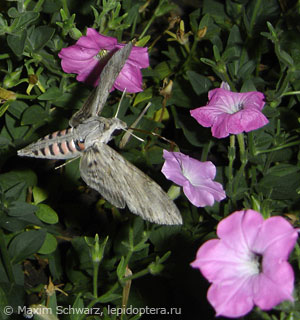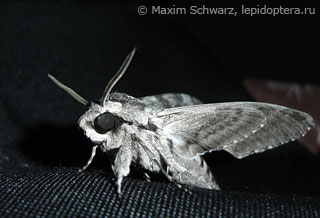Agrius convolvuli

Taxonomy
class Insecta
Species name(s)
Agrius convolvuli (Linnaeus, 1758) = Sphinx convolvuli Linnaeus, 1758 = abadonna (Fabricius, 1798) = Sphinx patatas Ménétriés, 1857 = Sphinx roseafasciata Koch, 1865 = Sphinx pseudoconvolvuli Schaufuss, 1870 = Protoparce distans Butler, 1876 = Protoparce orientalis Butler, 1876 = batatae (Christ, 1882) = alicea (Neuberger, 1899) = nigricans (Cannaviello, 1900) = fuscosignata Tutt, 1904 = grisea Tutt, 1904 = ichangensis Tutt, 1904 = intermedia Tutt, 1904 = javanensis Tutt, 1904 = major Tutt, 1904 = minor Tutt, 1904 = obscura Tutt, 1904 = suffusa Tutt, 1904 = tahitiensis Tutt, 1904 = unicolor Tutt, 1904 = variegata Tutt, 1904 = virgata Tutt, 1904 = indica (Skel, 1913) = marshallensis (Clark, 1922) = peitaihoensis (Clark, 1922) = aksuensis (O. Bang-Haas, 1927) = extincta (Gehlen, 1928) = posticoconflua (Bryk, 1946) = Herse convolvuli. [9, 10]
Convolvulus Hawk-moth.
urn:lsid:insecta.pro:taxonomy:2853
Expansion
This species marks on the maps: 2.
Zoogeographical regions
Palaearctic.
Russia regions
#1. Kaliningradsky; #4. Evropeisky Severo-Zapadny; #6. Evropeisky Severo-Vostochny*; #7. Evropeisky yuzhno-tayozhny; #8. Evropeisky Tsentralny; #9. Evropeisky Tsentralno-Chernozyomny; #10. Sredne-Volzhsky; #11. Volgo-Donsky; #12. Nizhnevolzhsky; #13. Zapadno-Kavkazsky; #14. Vostochno-Kavkazsky; #15. Severo-Uralsky; #16. Sredne-Uralsky; #17. Yuzhno-Uralsky; #20. Yuzhno-Zapadnosibirsky; #37. Nizhne-Amursky; #38. Sakhalin; #39. Yuzhno-Kurilsky; #40. Primorsky.
* An asterisk denotes a region for which the species is listed as an migrant or information that requires additional checking.
Forewing length
45—50 mm.
Primary colors
Red, Brown/Gray/Black.
Flight time
| January | February | March | April | May | June | July | August | September | October | November | December |
Larva lifespan
| January | February | March | April | May | June | July | August | September | October | November | December |

Detailed information with references
Distribution
Imago Habitus and Differences from alike species
General info about Imago
Imago lifespan
General info about Larva
Larva food plants / other food objects
Larva lifespan
Subspecies of Agrius convolvuli
- Agrius convolvuli aksuensis Bang-Haas, 1927. [187]
- A. c. marshallensis Clark, 1922. [187]
- A. c. peitaihoensis Clark, 1922. [187]
Authors
Initial species uploading to the site: Peter Khramov.
Text data: Peter Khramov, Alexander Belousov.
The species characteristics formalization: Peter Khramov.
References
- [1] O. Karsholt, J. Razowski (eds.), 1996. The Lepidoptera of Europe: a distributional checklist
- [3] Каталог чешуекрылых (Lepidoptera) России. Под ред. С. Ю. Синёва. СПб.; М.: Товарищество научных изданий КМК, 2008
- [5] Райххолф-Рим Х. Бабочки. М.: Астрель, 2002
- [9] Tree of Life (funet.fi), 2012
- [10] de Jong, Y.S.D.M. (ed.) (2011) Fauna Europaea version 2.4 (faunaeur.org)
- [28] Moths and Butterflies of Europe and North Africa (leps.it), 2012
- [187] Species 2000, http://www.sp2000.org
- [PC1149] Alexander Belousov
Comments
Note: you should have a Insecta.pro account to upload new topics and comments. Please, create an account or log in to add comments
Agrius convolvuli photos


































All the photos of the species in large size
Please, create an account or log in to upload your photo

